Spanakopita (Spinach Pie): Searching for the Best Crust
If you cannot roll the traditional homemade crust, try some other options besides the frozen phyllo that is far from what this iconic pie needs.
Pites (plural of pita, meaning ‘closed pie’) are diverse and wonderful, the kind of convenient seasonal food that only resourceful cooks with limited ingredients could invent. Wheat flour, water, and olive oil are the ingredients of the crust.
Enclosed between the multiple, crunchy layers of pastry you’ll find feta and other local cheeses, mixed with spinach or any kind of leafy greens and herbs, often foraged from the fields and hills.
Think of the pies as the Greek and Eastern Mediterranean ‘sandwiches’ since we do not have the tradition of enclosing cheese, meat etc. between slices of bread .
It is obvious then that we need to give as much attention to the crust as we do to the filling, much like bread slices are carefully chosen when preparing sandwiches.
Besides leafy greens, later in the spring and summer zucchini, eggplant or other vegetables from the garden make equally delicious pie filling.
Occasionally you may find pies with some meat that wouldn’t be enough to feed the family on its own. Less common are pies with octopus and other seafood mixed with rice or grain.
When for the first time I served to Costas a piece of spanakopita —30+ years ago-- which I thought it was good, he ate the filling, saying he loved it, but left the pieces of commercial phyllo crust on his plate. It was like cardboard, he said…
My mother didn’t roll phyllo so I didn’t learn the technique. Costas’ late mother, who rolled phyllo regularly, was not the best teacher, but years later I learned from friends who grew up in the north-western part of Greece and southern Albania.
Rolling phyllo from the age of 12 or 13, they are the experts who instruct our Kea Artisanal gests. I have not managed to make perfect phyllo, just adequate, while Costas’ is certainly better than mine!
Spinach and Cheese Pie (SPANAKOPITA)
My version of the traditional greens pie is made with raw chopped spinach or other leafy greens, herbs and onions. Spinach leaves are perfect, but any combination of spinach, chard, dandelion greens, arugula or mesclun will be delicious.
The chopped greens are rubbed or kneaded with salt and olive oil to wilt; they are always complemented by feta. In my version I like to go beyond feta alone and add a mixture of more pungent cheeses that enhance the pie’s flavor. The fragrant filling cooks slowly inside the crunchy, homemade phyllo and the resulting pie is wonderful, eaten warm or at room temperature (scroll down for the recipe).
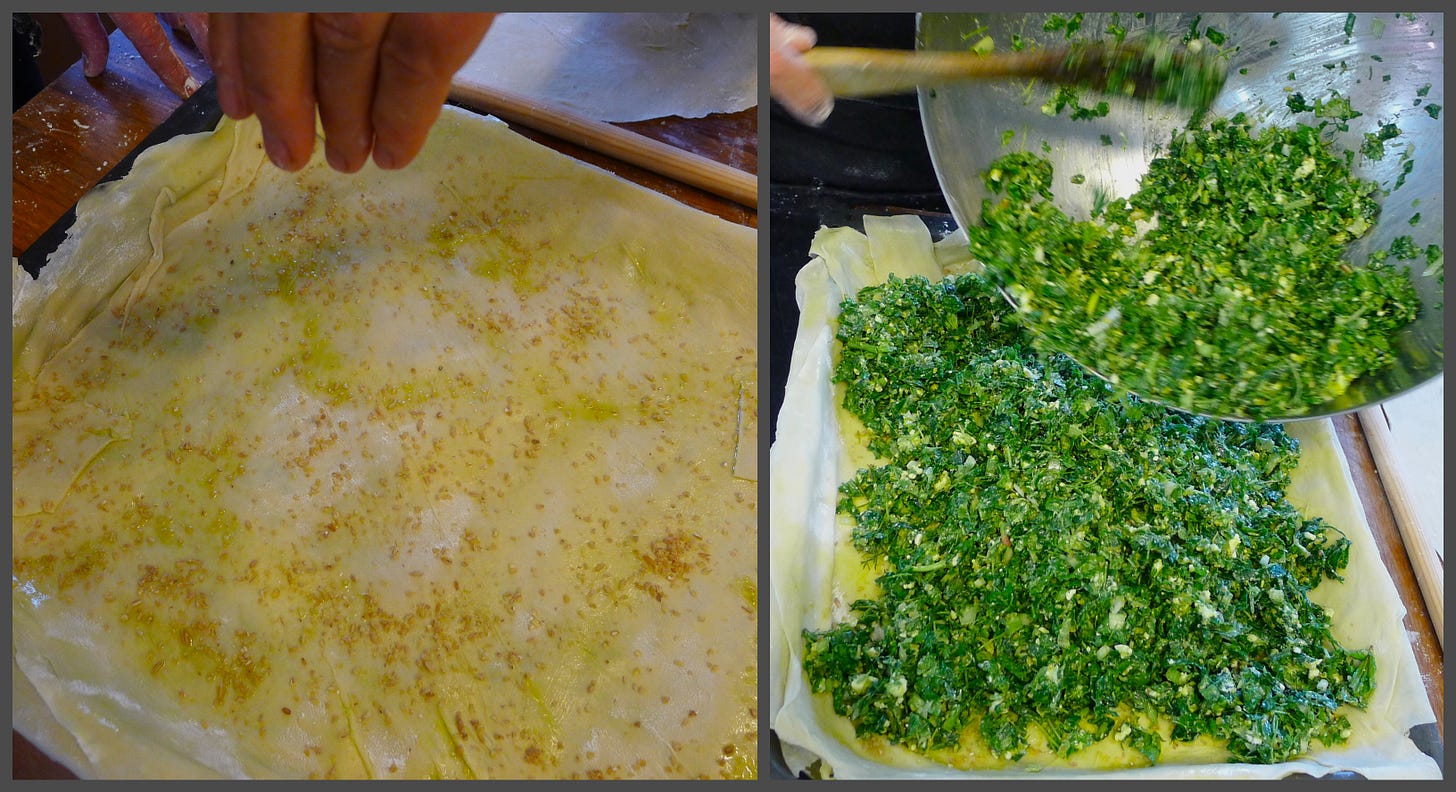
The bulgur or breadcrumbs that I spread under the filling absorb any extra moisture, ensuring that the bottom gets as crunchy as the top.
Trying alternative crusts
As I said, I despise the frozen thin phyllo available all over the world. But I know that it may be occasionally used by my readers, as well as guests and friends who, like me, have learned the technique, but are not really comfortable rolling phyllo from scratch. So over the years I have tried to find alternative spanakopita crusts.
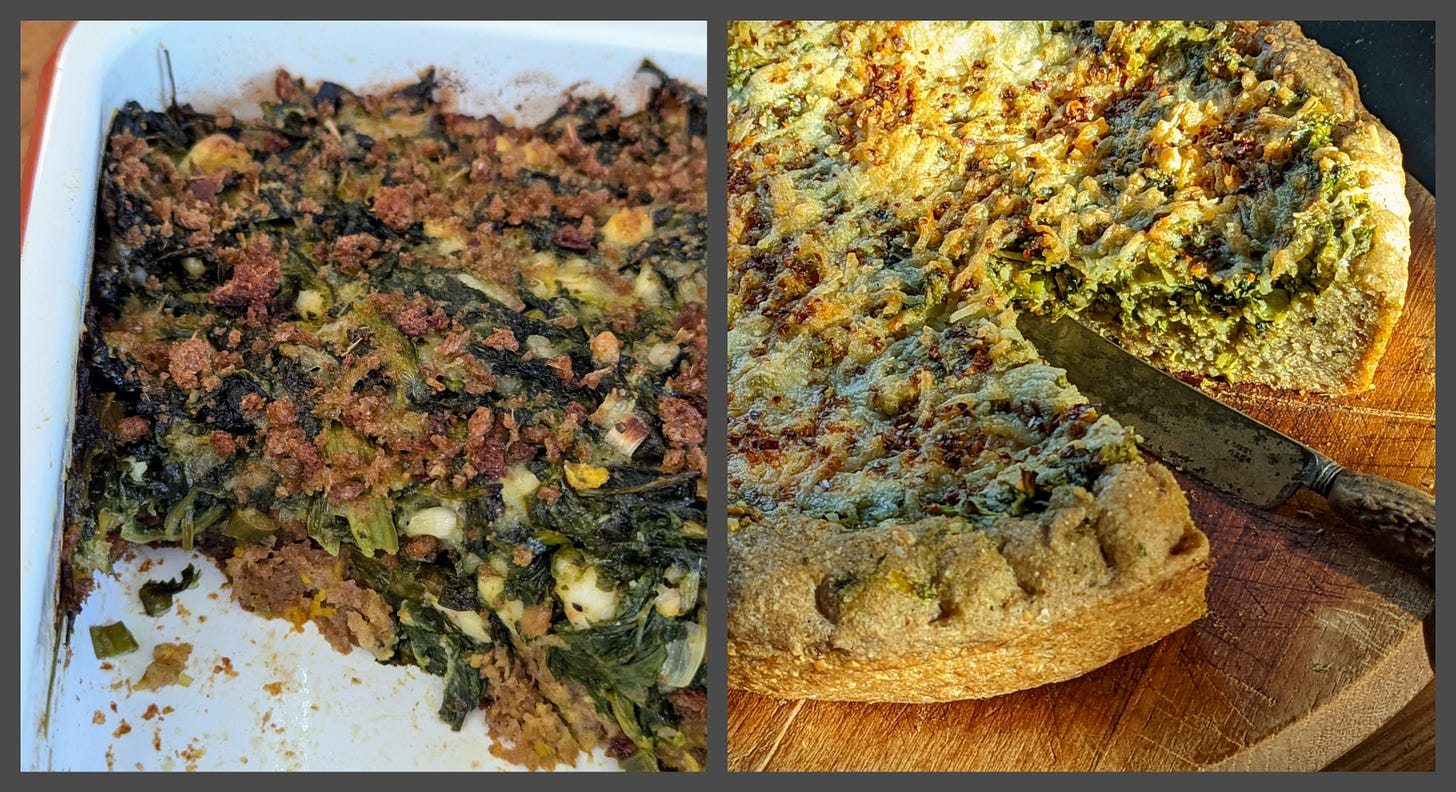
I had never made quesadillas or anything with tortilla but recently I considered experimenting with it, and both Costas and I really liked the result. It wasn’t like the proper home-rolled phyllo spanakopita, but it was definitely lovely!
Tortilla/quesadilla Spanakopita
Serves 2
Olive oil as needed
4 wheat large Tortillas
4 tablespoons grated pecorino or aged graviera
1 ½ cup spinach, herb, and cheese filling (see recipe below) that is rubbed, wilted and ready to be added to the pan
In a large skillet warm 2 tablespoons olive oil over medium-low heat and add a tortilla. Rub its top with olive oil and sprinkle 2 tablespoons grated pecorino or graviera over the whole surface. Add a second tortilla on top, lightly rubbed with olive oil and cook for a couple of minutes, pressing with a spatula and checking to see if the bottom is well cooked.
Flip the tortillas, lowering the temperature if they brown too fast. Spread 1 ½ cups of the spanakopipita filling (see recipe below) over the tortilla and cover with another one, that you have rubbed with olive oil. Sprinkle with 2 tablespoons grated pecorino or graviera and add the last, oil-rubbed tortilla on top pressing it with your hand or spatula.
By now the bottom must be well browned and the filling bubbling. Carefully flip the tortilla-spanakopita to cook and crisp on the other side. I had a second skillet and flipped it on that, but you can use a large plate or cutting board to flip it, as you do with omelets.
Cook, pressing the top until it is well browned at the bottom, then transfer to a wooden board and cut wedges to serve.
SPANAKOPITA with home-rolled phyllo
The fragrant filling cooks slowly inside the layers of homemade phyllo and the resulting pie is wonderful, with a lovely, crunchy crust. It can be eaten warm or at room temperature. If you decide to use frozen phyllo, brush the top with egg wash (see note), as I learned from my Turkish friends; this small addition makes the commercial, ordinary crust somewhat more interesting.
Serves 8 (10-by-15 inch pan)
THE PHYLLO (see Note for commercial phyllo)
4 cups all-purpose or bread flour
1 teaspoon salt
2 tablespoons vinegar
1/3 cup olive oil
About 1 cup water, as needed
Cornstarch, for rolling the sheets
SPINACH-CHEESE FILLING
10 packed cups shredded spinach leaves and tender stems (not baby spinach), trimmed -- you will need about 1 1/2 pounds spinach
1 cup finely chopped shallots
1 cup finely chopped scallions, white plus most of the green part
1 1/2 cups finely chopped fresh parsley
1 cup finely chopped fresh dill
1/2 cup chopped fresh mint leaves
3 tablespoons chopped fresh thyme or oregano, or 2 teaspoons dry
1 teaspoon sea salt
About 1 cup olive oil or as needed
2 cups crumbled Feta
1 cup aged Cheddar or a mixture of aged and smoked Cheddar
1/2 teaspoon freshly ground pepper
2 eggs, beaten lightly
3-4 tablespoons bulgur or dried whole-wheat breadcrumbs
The phyllo dough: In the bowl of a standing mixer add the flour and salt, make a well in the center and pour in the olive oil and vinegar. With the machine running slowly, pour in water, as needed, working the mixture for about 6 minutes to get a smooth and elastic dough. Cover the bowl with plastic wrap and let rest for 15 minutes and up to 2 hours.
The filling: In a large bowl combine the spinach, shallots, scallions, parsley, dill, mint, and thyme or oregano. Add salt and 1/3 cup olive oil. Rub well with your hands for a few minutes to mix and wilt the spinach and herbs; it will reduce to about 1/3 of its volume. Add the Feta, Cheddar, pepper and the egg. Stir well and set aside.
Roll the phyllo and assemble the pie: Divide the dough into 3 pieces. Take 2 of the 3 pieces, knead them together, and divide into 6 pieces, which you will use for the bottom of the pie. Divide the remaining 1 piece of dough, which you will use to roll smaller top sheets, into 4 pieces. Shape each piece of dough into a ball and cover, keeping the 6 and 4 pieces separate.
Line the pan with parchment paper and brush liberally with olive oil.
Take one of the larger pieces of dough to roll a bottom sheet. Sprinkle the work surface and the dough with cornstarch and roll to make an almost round sheet, about 16 inches across. Stretch carefully to extend it and cover the pan with about 1 1/2 inches hanging over the edges of the baking dish. Brush with olive oil and roll the next 5 pieces of dough in the same manner, brushing lightly with olive oil the surfaces of each sheet.
Sprinkle with the bulgur or breadcrumbs and pour in the prepared filling. Spread and level the filling with a spatula and drizzle about 1/3 cup olive oil over the filling.
Preheat the oven to 375˚F.
Roll the top 4 sheets of phyllo and place on the filling, inside the pan, brushing each sheet lightly with olive oil. Fold the overhanging bottom phyllo sheets over the top sheets without crimping—they will seal as they bake. Score a cross on the surface with a sharp knife and bake for about 1 hour, until golden brown on the top and bottom; the pie will shrink somewhat and will completely detach from the pan. Lift carefully using the parchment paper as ‘handles’ and transfer to a rack. Slide the parchment paper out from underneath the pie to prevent the bottom crust from becoming soggy. Let cool for at least 20 minutes before sliding the pie onto a serving platter or, preferably, onto a wooden board to take to the table and cut to serve.
Leftover pie keeps covered in the refrigerator for 3-4 days; it will freeze for up to 6 months. Reheat directly from the freezer in a 375˚F preheated oven, loosely wrapped in aluminum foil, for about 15 minutes. Open the foil and heat for another 5-10 minutes, turning once, to crisp the phyllo on both sides.
NOTE:
To make the pie with commercial frozen phyllo: Use the thickest phyllo you can find and thaw following the package instructions.
Lay one more than half of the sheets in the package at the bottom of the pan, brushing each sheet lightly with olive oil. Sprinkle with bulgur or breadcrumbs, pour in the filling and top with the rest of the sheets, brushing with olive oil. Crimp the border and press it with the tines of a fork to prevent burning.
I suggest you brush the top liberally with egg wash, just before baking, to make the crust more interesting.
Egg wash (optional): Whisk together 1 small egg yolk with 3 tablespoons of milk or natural yogurt (with a thin consistency).



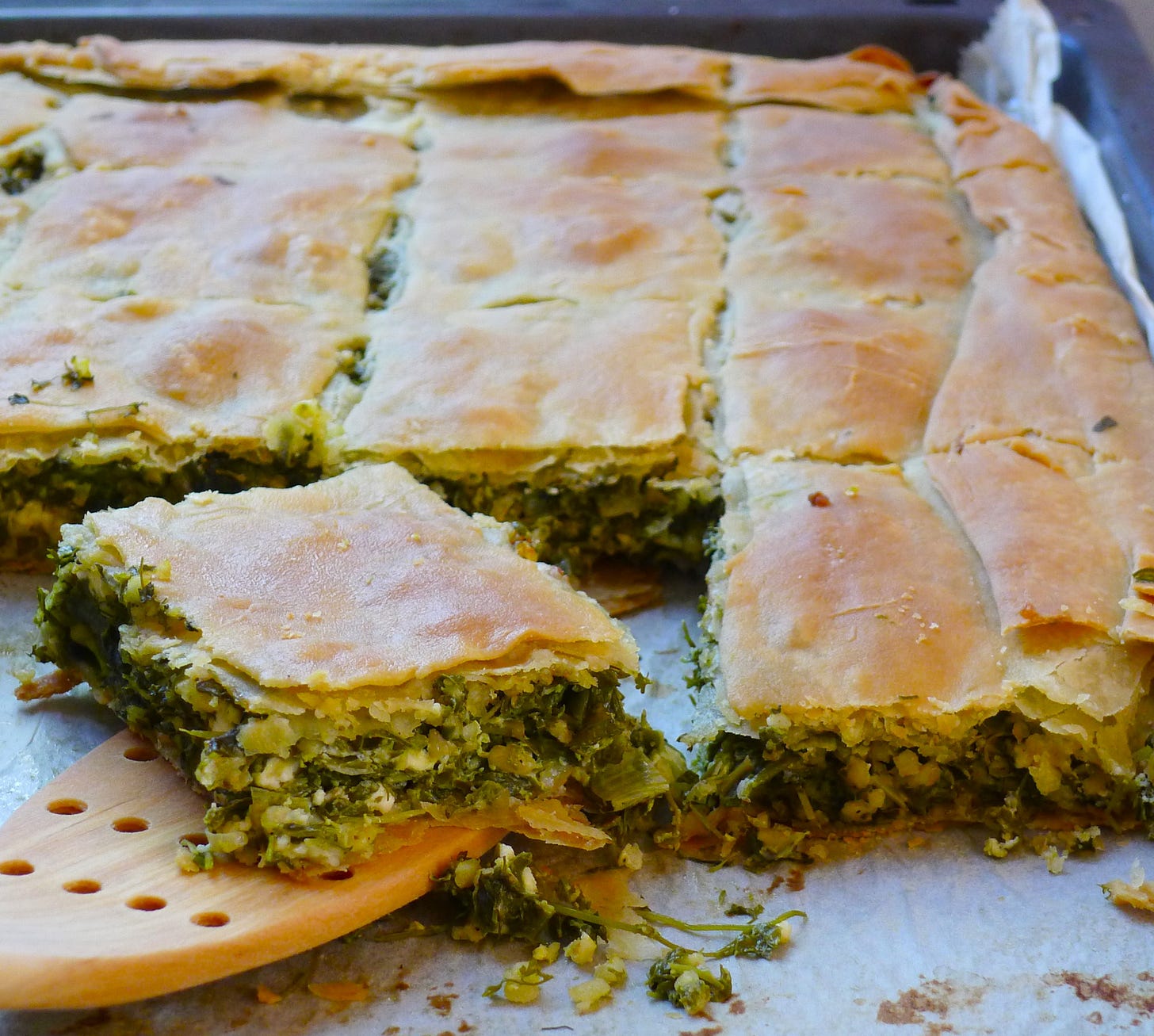


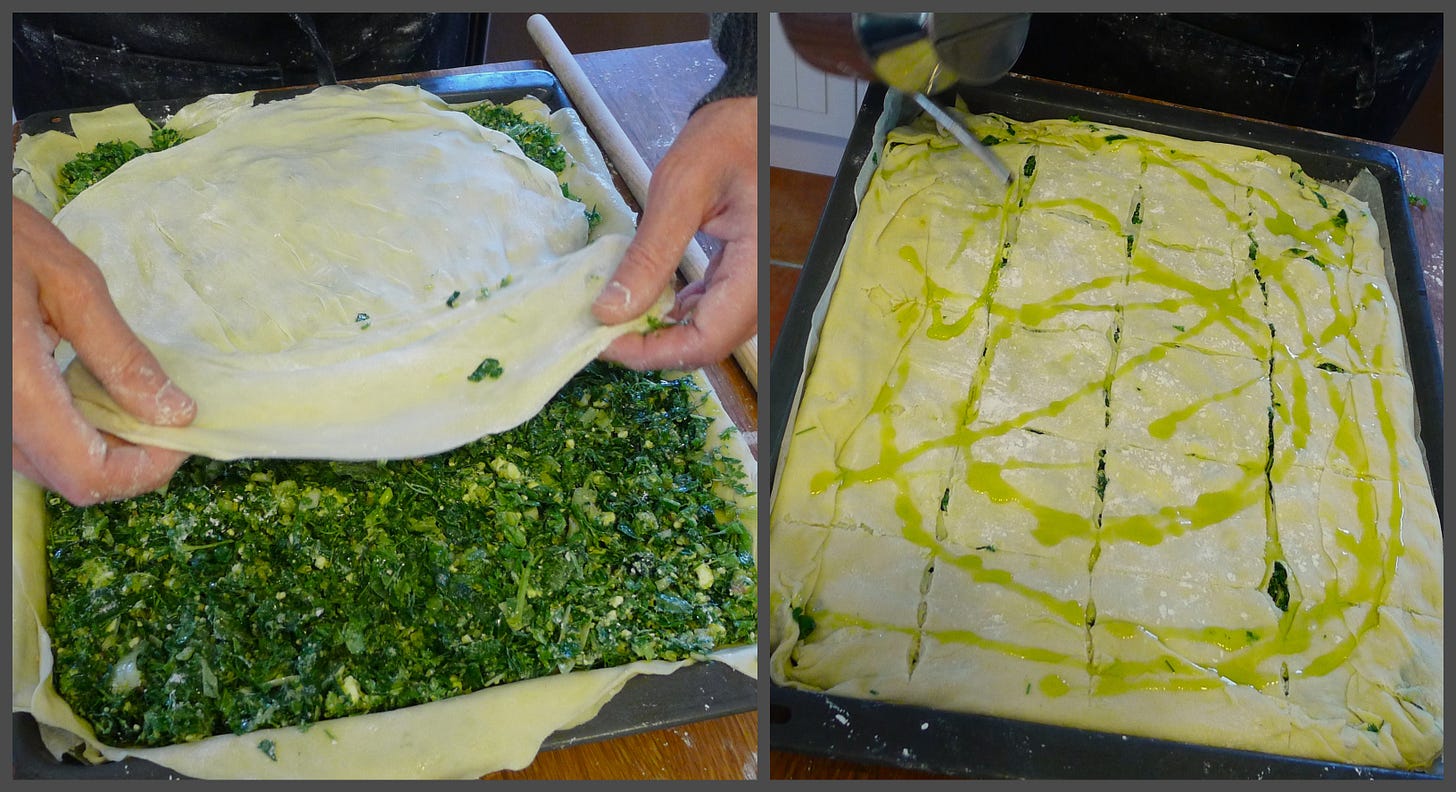


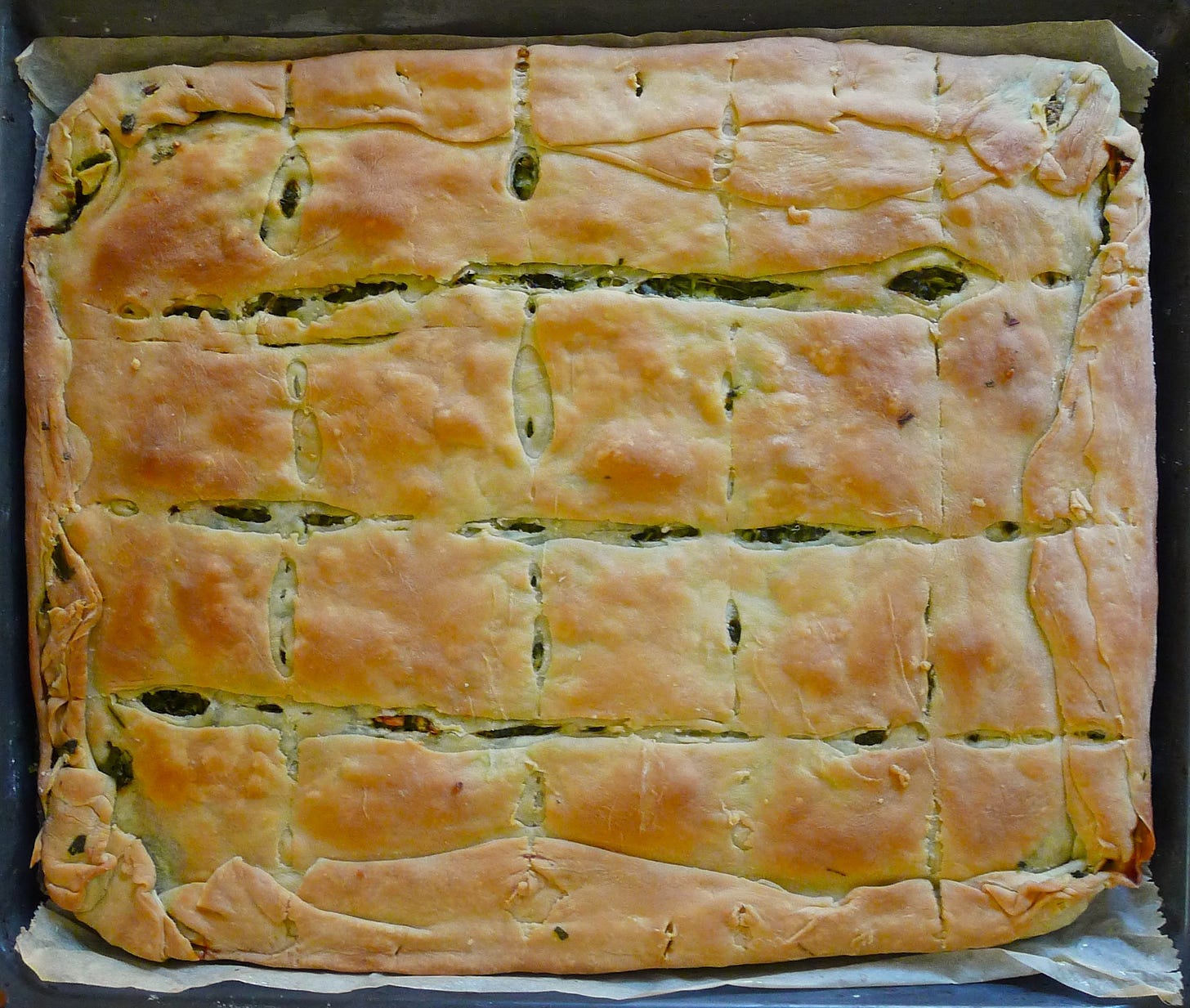

Love the idea of pie instead of sandwich - lovely post, Aglaia!.
Beautiful pies! It’s been too long since I’ve had one. Saving this recipe for my next spanakopita.